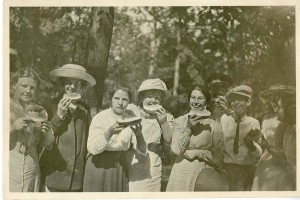Hartford Public Library’s Hartford History Center will presenting a new online exhibit called “Hartford Springs Into Summer,” a photographic history of the city’s park system.
The exhibit will go live on May 17 with an online presentation taking place on Zoom and Facebook Live at 7 pm.
The exhibit can be found here: https://hartfordparks.omeka.net/exhibits/show/springintosummer/title
HHC Historical Research Specialist Maureen Heher will share information about how the photographs were selected. Archivist Jennifer Sharp will discuss newly available archival material from the Parks Collection, and how it is a starting point for research about the city, both in and out of the parks.
Sharp has been working with the collection, which is comprised of thousands of images and documents, creating finding aids and cataloging what’s there. “There is another half of the collection, that has pretty much never been touched,” Sharp said.
The photos are a time capsule of life in Hartford around the turn of the century. Parks Department photographers chronicled a wide array of events in the city’s parks and which people felt comfortable attending them.
The collection sat in storage at City Hall until a city councilor discovered them in the 1980s. Later on, the collection was given to the Hartford History Center.
“We don’t know the names of the photographers. We don’t know the names of the people in the photos. If we are lucky we have an inscription and a date,” Heher said.
By the 1920s, most of Hartford’s park network was well established and popular with the public. With workers receiving more time off on the weekends and prosperity rising, park usage skyrocketed. City officials believed that the parks could provide the healthy access to nature that people in rural communities already had. “It is a microcosm of the city’s history,” Sharp said.
In 1912, the Parks Department announced that 660,000 people frequented a park. At that time, Hartford’s population was approximately 127,000 people. A year late the department expected that close to a million people was spend time in a city park.
The photo exhibit shows that the parks took on their own identities. There are pictures of scrappy kids playing. Adults buy and sell refreshments. People played cricket. People who strolled Elizabeth Park’s rose gardens did so in their Sunday finest. “There was still this sense that Sundays were a day for family. You know, your church and family,” Heher said.
There is a sense of innocence and charm in many of the photos – you are watching a city working hard to amuse itself. “Celebrations were a big deal. While, yes, the Fourth of July, Memorial Day, and Labor Day were big things in the city back then. But Flag Day was also huge. And May Day and Arbor Day. These were big celebrations that we don’t even really recognize these days anymore,” Heher said.
For Sharp and Heher, the photo collection is just one more example of how much the Hartford History Center has to offer. “I want people to know how much information they have access to,” Sharp said.
– By Steven Scarpa, manager of public relations and communications
